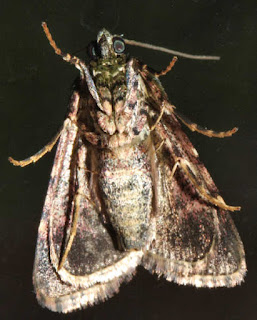Orthaga PYRALIDAE
Orthaga Possibly thyrisalis EPIPASCHIINAE PYRALIDAE
The Orthaga moths are difficult to tell apart. I have this one down as O. thyrisalis, and if it is, the larval food plants are likely to be, according to the Butterfly house site:-Teatree ( Leptospermum ), in our case a Lemon Scented Teatree
Paperbarks ( Melaleuca species), we have several of these.
I have not been able to cross reference this information, and there is no mention in Moths of Australia (Common 1990) of the larval food plant, or in any of my other larval food source references.
Family:- PYRALIDAE
Sub Family:- EPIPASCHIINAE
Genus:- Orthaga
Species:- Possibly thyrisalis
************************************************************************************
Orthaga Species EPIPASCHIINAE PYRALIDAE
Without a positive identification it is not possible to find anything about its biology.Family:- PYRALIDAE
Sub Family:- EPIPASCHIINAE
Genus:- Orthaga
Species:- Sp.
***********************************************************************************
Orthaga Species EPIPASCHIINAE PYRALIDAE
I think this one is an Orthaga too.
Family:- PYRALIDAE
Sub Family:- EPIPASCHIINAE
Genus:- Orthaga
Species:- Sp.
***********************************************************************************















